Abstract
The religious color of folk beliefs and customs, a concrete and ideal artistic presentation of the Mazu (媽祖) image reflected in ancient books, folk customs and myths, endows Mazu with its unique image and humanistic connotation. The visual image, which implies the meaning of the thought, serves as important material for historical research. Therefore, this paper refers to and draws on three changing images of Mazu summarized from the perspectives of state and society, social function, and region of belief, respectively, by anthropological researcher Mr. Bozhong Li in his study of Mazu. Based on the analysis of Mazu image data, three significant images of Mazu are proposed, namely, the initial image, the transformation image and the typical image, along with a comprehensive analysis of its evolution and relationship. The image of Mazu in the statue is not only an artificially constructed social and cultural symbol but also a folk art symbol with religious and folk characteristics, and secular and emotional characteristics. It is also the visual form of Mazu’s intuitive concrete materialization, carrying a certain representative thought and concept, meaning and spirit, and the various pieces of information it contains is more intuitive than words, bringing the incomparable dissemination power of knowledge and information from the classics. Moreover, it can transcend language barriers and regional boundaries, stimulate personal inner original feelings, interact with Mazu’s beliefs and customs, and serve as an important medium for spreading Mazu’s beliefs and customs.
1. Definition of “Mazu Figure” and “Mazu Image”
For the two words “figure” (xingxiang 形象) and “image” (xingxiang 形像), the basic interpretation in the dictionary is the figure, also known as the image. However, the meaning of “figure” differs from “image”. “Figure” refers to the shape or appearance; “figure” does not refer to the thing itself, but the overall impression of a thing formed through the perception of the specific shape and posture, which can arouse people’s thoughts or emotional activities. “Image” refers to an image made of a person, and “image” refers to the inherent appearance and image of an object itself. The Mazu image runs through the whole process of Mazu, from human to witch (nüwu 女巫) and from witch to goddess, and its formation process is also a process in which emperors and believers of previous dynasties, proceeding from their respective standpoints, perspectives and interests, shape Mazu differently, transform it in accordance with their time and constantly improve it (Zhang 2019). Therefore, the Mazu image has evolved into an image-based cultural symbol accumulated over a long history. It is a constructive materialized carrier for people at different historical stages to express their spiritual and emotional sustenance or convey the meaning of folk religion in real life.
Mr. Bozhong Li 李伯重 believes: “In the study of Mazu, a key issue is the Mazu image” (Li 2004, p. 288). If researchers do not understand the Mazu image correctly, there will be confusion in the research process, leading to different research conclusions. Mazu’s image is constantly changing over time and place. “Mazu is a goddess of a thousand-faced Avalokitesvara (Qianmian guanyin 千面觀音). The Mazu seen by different people is only an image formed by certain aspects of her” (Li 2004, p. 289). At present, scholars have discussed the “Mazu image” from different angles, and there are many related works and papers. They all provide in-depth analyses of the image of Mazu and give their unique interpretations of the image of Mazu in specific contexts, involving disciplinary research perspectives such as folklore, anthropology, religion, literature, iconography, and history (Li 1995, 1997; Lin 2003, 2020; Yu 2007; Zheng 2013; Wang 2014).
Although the research on the “Mazu image” regarding folk beliefs and the “Mazu image” from the perspective of iconography has also shown an upward trend in recent years, there is still more room for expansion and in-depth research. Therefore, this paper will mainly discuss the specific images of Mazu pictures and statues used for worship; that is, the “Mazu image” as regarded as a form of expression and visual symbol in folk religious art. Of course, the “Mazu image” in the art form also refers to the “Mazu image” reflected in ancient books, folk customs, myths, etc., which is a specific and ideal Mazu shape and appearance in the minds of believers, presented and reproduced by means of a variety of artistic expression techniques, such as a plane or three-dimensional, combining the Mazu image that was perceived in the belief circle over different periods of history, and is an artistic perspective analysis closely linked to the Mazu image and the statue itself.
From the pictures and statues of Mazu ranging from the Song dynasty (960–1279) to the Qing dynasty (1636–1912), we can see that, with the transformation and development of belief in time and space, under the interactive relationship between human beings and god, the Mazu image worshipped in folk beliefs has quietly changed in accordance with time, place, people and events, and the Mazu image has taken rich and diverse artistic forms. However, the Mazu images and statues may be endowed with different religious beliefs, priesthood spiritualities, and cultural images, and present different forms, contents and characteristics in the form of artistic materialization. The author summarizes the Mazu images as initial, transformational, and typical images.
Mr. Bozhong Li (1997) says that, according to the country and society, the social function and the belief area, the Mazu image can be divided into three major images, namely, “homeland god” (xiangtu zhi shen 鄉土之神), “official god” (gongwu zhi shen 公務之神) and “maritime god” (haishang zhi shen 海商之神). The evolution of the Mazu image includes not only the respective changes in the three major images but also the differences between them. The same is true of the initial, transformed, and typical images in the Mazu image and the statue. The three images have obvious characteristics and certain intersections and connections. Therefore, the author believes that there are certain causes and consequences between Mazu’s “three figures” and “three images” (as shown in Figure 1). Based on this, the following will be based on the three figures of “homeland god”, “official god” and “maritime god” summarized by Mr. Bozhong Li, focusing on the evolution and relationship of the initial image, transformation image and typical image of Mazu in the picture and statue.
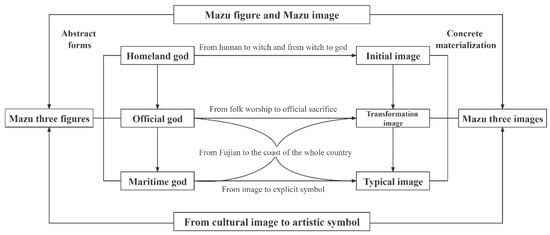
Figure 1.
The relationship between the Mazu figure and the Mazu image. Source: Drawn by author.
2. Figure of the “Homeland God” and the Initial Mazu Image
2.1. “Homeland God”: The Mazu Image Is “Loved and Respected as One’s Mother (ai jing rumu 愛敬如母)”
The so-called “homeland god” refers to the good god (shanshen 善神) who blesses the people in one area, especially the god who is in charge of all aspects of people’s social life in one area. As there are so many things to be in charge of, this kind of god must have many kinds of divine powers. One of the reasons why Mazu is regarded as the “homeland god” in Fujian is because Mazu has a multi-functional god image, such as “saving shipwrecks, saving floods and droughts, curing plagues, pacifying pirates, subduing demons and suppressing evil spirits, subduing monsters, helping repair water conservancy, saving the hungry, navigating and guiding the way, gifting children, preserving fetuses, etc.,” which is mainly limited to Fujian (as well as Chaoshan 潮汕, Taiwan and other places with similar cultural traditions to Fujian). Secondly, among the many local deities in Fujian and other places, Mazu’s status is becoming more and more lofty, and Mazu’s divine power is becoming more and more diverse. Due to the official sacrifice seal, Mazu surpasses other local deities and leaps to the highest deity level. Mazu became a local protector in the hearts of the Fujian people, and Mazu belief has also become a symbol of Fujian local culture (Li 2004, p. 290).
Mazu beliefs can be traced back to the female worship of Fujian ancestors. Fujian was originally the seat of the Minyue Kingdom 閩越國 (334 BC–214 BC), with a long tradition of “advocating witchcraft (wushu 巫術) and ghosts” (hao wu shang gui 好巫尚鬼) and “witches and wizards” (nüwu nanxi 女巫男覡). The custom of “believing in witches and ghosts, advocating prostitution and sacrifice” (xin wugui, shang yinsi 信巫鬼、尚淫祀) has continued to later generations, and witches (nüwu 女巫) are still popular among the people. For example, Liang Kejia 梁克家 (1127–1187), a native of the Southern Song dynasty (1127–1279), recorded in the Gazetteer of Three Mountains (Sanshan zhi 三山志) that among the people in Fujian, “there are more than ten witches in each village” 每一鄉率巫嫗十數家 (Liang 2000). At the end of the Song dynasty, Gazetteer of Xianxi (Xianxi zhi 仙溪志) recorded: “It was written by immortals or witchcraft, all of which were worshipped by folk customs and recorded in sacrificial ceremonies” 或以神仙顯,或以巫術著,皆民俗所崇敬者,載在祀典 (Huang 1989). This reflects the status of witches in Fujian folk customs, and it is a widespread phenomenon that witches control the fate of villagers. At the same time, since ancient times, women in Fujian have become the main force in the family in terms of participatation in field labor and conducting business in the streets because their husbands go to sea to fish, so they have a higher status in the family. In addition, many women in Fujian are engaged in witchcraft (wushu 巫術). Some are respected during their lifetime and worshipped after death, and gradually develop into gods (Sangren 1983). Therefore, worship of the goddess has been more prevalent in the history of Fujian.
Most Fujian goddesses were witches in their lifetime or were thought to be witches or female Taoist priests (nüdaoshi 女道士). Records of Mazu from human to witch, such as from Liao Pengfei’s 廖鵬飛 (date unknown) Record of Rebuilding the Ancestral Temple at Shengdun as Timely Salvation Temple (Shengdun zumiao chongjian shunji miaoji 聖墩祖廟重建順濟廟記) in the 20th year of Shaoxing 紹興 (AD 1150), to Huang Gongdu’s 黃公度 (1109–1156) Inscription of Shunji Temple (Ti shunjimiao 題順濟廟) in the same period, from Gazetteer of Puyang (Puyangzhi 莆陽志) in the 3rd year of Shaoxi 紹熙 (AD 1192) to Gazetteer of Xianxi in the 5th year of Baoyou 寶祐 (AD 1209). They repeatedly showed that Mazu was a witch who was active in the Meizhou 湄洲 Island area. Although the titles of the imperial court gradually increased because of Mazu’s different spiritual deeds, from the original “lady” (Furen 夫人) to “heavenly concubine” (Tianfei 天妃) and “queen of heaven” (Tianhou 天后), the folk titles became more and more popular, from “goddess” (Shennü 神女) to “spirit girl” (Lingnü 灵女), and then to “mammy” (Niangma 娘妈) and “Mazu” (Boltz 1986). Under the influence of official and folk titles, Mazu has always been portrayed as a kind and friendly woman in Fujian folk.
2.2. The Initial Mazu Image: The Same Form of God and Human (shenren tongxing 神人同形)
Folks in Fujian regard Mazu as a spiritual mother, and the people regard him as a close relative who lives with him in the same country. Therefore, Mazu, as a “homeland god”, is popular in Fujian folk society and folk life. However, there is no specific description of the Mazu image in early historical documents. The initial Mazu image can be found in some existing flat images depicting the Mazu stories since the Ming (1368–1644) and Qing dynasties. The traditional images of Mazu stories, whether folk or official, are either painted on silk paper and framed for hanging, engraved and printed in books, or depicted on the two walls of Mazu temples, which not only popularize and publicize Mazu beliefs, but also enhance the believers’ understanding of Mazu’s life and spiritual stories. Whether the Qing dynasty fine brushwork painting Scroll Record of Sagely Manifestation from the Celestial Empress (Tianhou xiansheng tuzhou 天后顯聖圖軸) collected by Fengtang Palace (a folk village temple) in Xiangyou, the Pictorial Record of the Miracles Performed by the Holy Mother and Heavenly (Tianhou shengmu shiji tuzhi 天后聖母事蹟圖志) collected by the National Museum of China, or the line-bound book The Full Picture of the Treasure Image of Lin Mazu (Lin Mazu zhi quantu baoxiang 林妈祖志全图宝像) in the Republic of China, it depicts the birth of Mazu in the form of a mortal baby (shown in Figure 2). The mother who just gave birth to Mazu is sitting on a bed inside the house, and a white-clothed Guanyin (Baiyi guanyin 白衣觀音) is painted above the house, indicating that Mazu is given by Guanyin. This portrays that Mazu was age 16 when she received the talisman (shenfu 神符) from the God of Wells (jingshen 井神), who was a mortal girl with her head in a double bun (shown in Figure 2: middle). After Mazu obtained the talisman and gained some sorcery divinity, perhaps sprinkling water with a talisman to subdue ghosts in the Gaoli 高里 Township, perhaps the Putian 莆田 county officials asked Mazu for the talisman to fight epidemics and save people, or perhaps Mazu usd the talisman to help the villagers cure diseases. Mazu is depicted as a young woman in a robe (beizi 褙子) or a skirt (ruqun 襦裙) (shown in Figure 2: below).
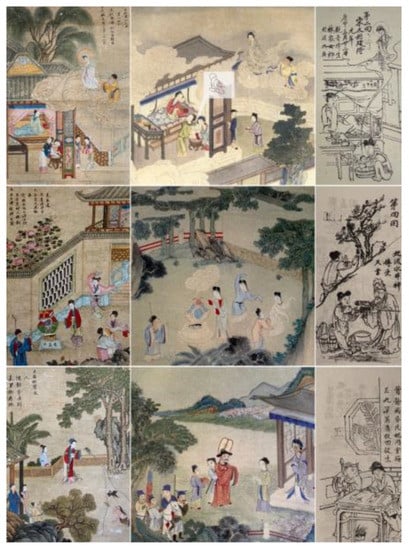
Figure 2.
Xiangyou Fengtang Palace collection “Scroll record of the Miracles Performed by the Celestial Empress”, the National Museum of China Collection “Pictorial Record of the Miracles Performed by the Holy Mother and Heavenly” and the Republic of China rice paper lithograph wire bound book “The Full Picture of the Treasure image of Lin Mazu”. Source: Author’s photograph.
When Dr. Klaas Ruitenbeek, a researcher at the University of Munich, visited Fengting 枫亭 Town of Xianyou 仙游 County in 1991, he took pictures of the Mazu Temple in Fengting Town, Xianyou County and murals about the miracle of Mazu were painted on the walls on both sides (Ruitenbeek 1998). There are four rows and seven columns of murals, which are composed of 28 small paintings. Among them, the caption reads “The holy mother helps the Qing army eliminate Zheng Guosheng” 聖母助清兵除滅鄭國勝 in the second column of the fourth row (Figure 3: left), “The goddess quells the evil dragon spirit” 神姑收伏孽龍精 (Figure 3: middle), and “The divine nun wants to swim in the sea and the gods send her out of the Southern Heavenly Gate” 神姑要游大海 諸天神送出南天門 appear in the fifth and sixth columns of the fourth row (Figure 3: right). In these three murals, Mazu’s appearance is almost the same, wearing a red robe outside, a long yellow skirt inside, a scarf in a bun (ji 髻), and a light-colored, four-fold Ruyi 如意 pattern-style cloud shoulder (yunjian 雲肩). Mazu is stepping on auspicious clouds (xiangyun 祥雲), or waving fly whisk (fuchen 拂塵) with his hands, or depicted with both hands covering the sleeve to make a bow (yi 揖), or both hands holding the sword shape. This is a folk painter, who vividly depicts the spiritual and approachable Mazu image in the eyes of Fengting villagers in a simple, rural way.
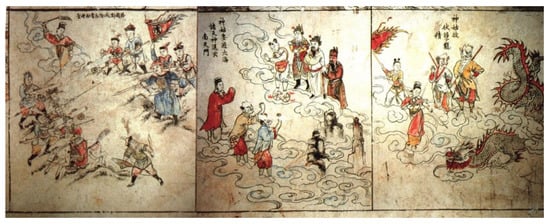
Figure 3.
Three murals on the side wall of the Mazu Temple in Fengting. Source: Photo by Dr. Klaas Ruitenbeek, researcher at the University of Munich, 1991.
The initial Mazu image can be vaguely seen from its transformation from human to witch, from witch to goddess, and from the comparison of the goddess’s three-dimensional statue, which has considerable influence in Fujian. There is a saying in Fujian folk: “Putian has Mazu, Gutian has Jinggu” 莆田有媽祖,古田有靖姑. Chen Jinggu 陳靖姑 is said to have been born in the second year of Tianyou 天佑, Emperor Ai of the Tang dynasty 唐哀帝 (892–908), and died in the third year of Tiancheng 天成, the Later Tang dynasty of the Five dynasties (905–928). The worship of Chen Jinggu by Fujian people began in the Tang (618–907) and Song dynasties, and its primary function was to protect women and children. The worship area was mainly concentrated in the East Fujian language area, with Gutian 古田 as the central part. This was an important deity worshipped by Fujian mothers, and was also called Mammy (Nainiang 奶娘), Lady Mammy (Furen nai 夫人奶), Linshui Mammy (Linshui nai 臨水奶), Lady Big Mammy (Danai furen 大奶夫人), etc. (Lo 1993). The two goddesses of Fujian folk beliefs, Mazu belief and Chen Jinggu (Lady Linshui), have certain differences in their origin and spread, but there are many striking similarities. For example, Mazu and Chen Jinggu (Lady Linshui) were both witches during their lifetimes, and they underwent a transformation process from witches to goddesses. Lian Zhenbiao 連鎮標 believes that the definition of Chen Jinggu (Lady Linshui) changed over time, from being a witch to a goddess, which should be the sign of the establishment of the Linshui Palace 臨水宮 in Gutian 古田 (Lian 2005). When people built a temple to worship Chen Jinggu (Lady Linshui), they created gods for her, that is, the transformation from human to goddess, which also promoted the birth of Chen Jinggu as a cultural image and the formation of the Lady Linshui belief. There are two versions of the time at which Gutian Linshui Palace 古田臨水宮 was established: one is the eighth year of Zhenyuan 貞元 in the Tang dynasty (AD 792), and the other is the fourth year of Tiancheng 天成 in the Later Tang dynasty (AD 929). Whether in the middle of the Tang dynasty or the late Tang dynasty and the Five dynasties, the change in Chen Jinggu (Lady Linshui) from witch to goddess obviously occurred earlier than Mazu after the Song dynasty, and the belief of Chen Jinggu (Lady Linshui) in Fujianalso started before the Mazu worship. A camphor wood statue of Chen Jinggu (Lady Linshui) was found in Qianyun 前運 Village, Dongzhuang 東莊 Town, Xiuyu 秀嶼 District, Putian 莆田, Fujian. On the movable wooden board behind the statue, there is an inscription, “Built in the second year of Zhenzong in Song dynasty” 宋真宗二年建 (Ke 1991), which is consistent with the Legendary Biography of Chen Shisi (Chen shisi qizhuan 陳十四奇傳) and the local legend that Chen Jinggu received the imperial title in the second year after Zhenzong ascended the throne (AD 999). Hence, academic circles and believers conclude that the statue appeared in the Northern Song dynasty in 960–1127. Located in Gangli 港裡 Village, Shanting 山亭 Township, Xiuyu District, Putian, a wooden statue of Mazu is preserved in the Xianlianggang Queen of Heaven Ancestral Temple 賢良港天后祖祠. Compared with the wooden statue of Chen Jinggu (Lady Linshui) in Qianyun Village, “It is found that both of them are not only identical in structure and shape, but also have the same degree of damage. One leg is damaged, the hair is spiral, and the face carving is exactly the same” (Chen 2006). Compared with Mazu, the birth and death time, the emergence of worship customs, and the sacrificial temples are obviously earlier than Mazu. Based on these factors, current researchers use the wooden statue of Chen Jinggu (Lady Linshui) to infer the age of the statue of Mazu at the Queen of Heaven Ancestral Temple in Xianlianggang.
Later, with the transformation of Mazu from a human to a goddess, in addition to the two goddesses being worshipped separately in temples, there was also a phenomenon of multiple goddesses being worshipped in the same palace among the people, which has been extended to the rural areas of Fujian, Zhejiang, Jiangxi and Guangdong, among which, the custom of “three concubines worshipping together” (sanfei hesi 三妃合祀) is more common. For example, in the field investigation, it was found that there were three goddesses in the Queen of Heaven Palace in Wujiafang 伍家坊天后宮, Ninghua 寧化 County, with similar heights of about 1.5 m, and their crowns, clothes and body shapes were almost the same (Ye and Zhang 1997). According to the temple official (miaozhu 廟祝), the three statues of soft-bodied (ruanshen 軟身) goddesses are as follows: the one in yellow robes in the middle is Chen (Chen Jinggu: Lady Linshui), the one in red robes on the left is Lin (Lin Jiuniang 林九娘: Mazu), and the one in green robes on the right is Li (Li Sanniang 李三娘: Lady Li) (Ye 2010). The Palong Temple in Xianyou County 仙游縣壩壟宮 also houses three statues of goddesses in the same shrine, with Mazu in the middle, Lady Linshui on the left and Concubine Wu Zhenma 吳真媽 on the right (As shown in Figure 4). The three goddess statues are almost identical in shape and sitting posture, except for the slightly longer face of Mazu and the different colors of the belt around her waist. For folk believers and artisans, there is no fixed paradigm (fanshi 範式) regarding what kind of specific image the gods should take. They are always shaped according to the most ideal concrete form, or with reference to the image of more influential gods from the same period.
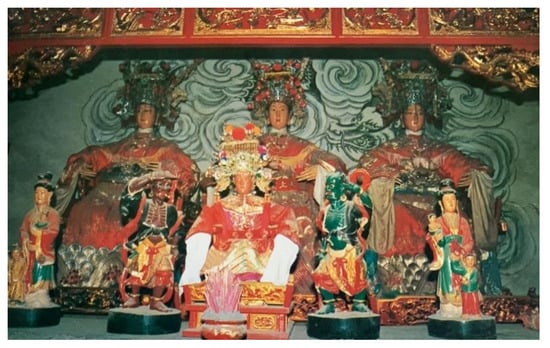
Figure 4.
The Palong Temple in Xianyou County also houses three statues of goddesses in the same shrine. Source: author’s photograph.
In the three-dimensional statue, Mazu is also portrayed by the public and artisans as a typical image of a woman who wears a bun during her daily life. Whether the carved Mazu statue in the Putian Museum, the Mazu statue in the Wenfeng Palace 文峰宮 in Putian, Fujian Province, or the painted wooden Mazu statue in the Chinese Wood Carving Museum 中國木雕博物館 in Dongyang 東陽, Zhejiang Province (Figure 5), they are all shaped into the image of a lady with a round face, a kind eye and a kind face. Until the Ming Dynasty, Mazu was still seen by the people with this dignified and beautiful appearance, just as Xie Zhaojiu 謝肇淛 (1567–1624) of the Ming dynasty recorded in Five Assorted Offerings (Wuzazu 五雜俎): “the imperial concubine of heaven is the god of the sea...Nowadays, people who offer sacrifices are more likely to be like women, which is the same as those who offer sacrifices to Avalokitesvara, but they do not realize that they are wrong” 天妃,海神也。……今祀之者,多作女人像貌,此與祀觀音大士者,相同習而不覺其非也 (Xie 1935). The plot of Avalokitesvara Sending Son (Guanyin songzi 觀音送子) in the narrative of Mazu’s Birth (Mazu jiangdan 媽祖降誕) in the Original Legends of Celestial Consort’s Birth (Tianfei danjiang benzhuan 天妃誕降本傳) and the plot of Illustrated record of the Sagely Manifestation in Meizhou (Meizhou shengji tu 湄洲聖跡圖) in Record of the Miracles Performed by the Heavenly Princess (Tianfei xiansheng lu 天妃顯聖錄) are painted with Avalokitesvara Hall (Guanyin tang 觀音堂). It is enough to say that there are records of “the combination of Avalokitesvara and Mazu” in the literature of the Ming dynasty. It can also be said that Mazu is the incarnation of Avalokitesvara, and the divinity between Mazu and Avalokitesvara is very close. As Chen Wangdao 陳望道 pointed out in an article: “Avalokitesvara is like the mother of the common people, who always bestows her mother’s love to all those who believe in her; Mazu is also the mother in the minds of the common people, she lives in the unseen world and blesses their safety; Secondly, Avalokitesvara is a goddess, who will bless women to overcome difficulties in life. Mazu was also the god of pregnancy in Putian, who will bless women’s life problems such as pregnancy, childbirth and infant care; Thirdly, Avalokitesvara, who lives in Putuo 普陀 Mountain in the South China Sea, has always been the navigation protector of fishermen in this area, and Mazu has carried forward this divinity of Avalokitesvara and become a full-time navigation protector. It can be said that Mazu is the incarnation of Avalokitesvara. Most of the early Mazu temples had a special Avalokitesvara hall, and there were monks offering sacrifices” (Chen 2007). People’s impression of Mazu in the Ming dynasty was influenced by the image of Avalokitesvara formed before Mazu.
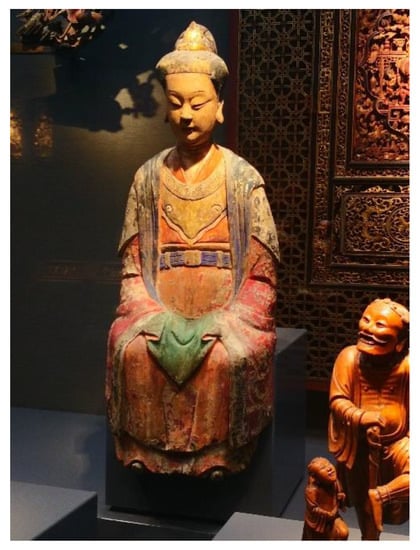
Figure 5.
The painted wooden Mazu statue in the Chinese Wood Carving Museum in Dongyang, Zhejiang Province. Source: Author’s photograph.
Thus, it can be seen that the initial Mazu image is based on the prototype of women living in Fujian, referring to, learning from and even imitating the image of the goddess with a greater influence in the same period and in previous generations, based on the identity and form of Mazu in her lifetime and after she ascended to heaven, with idealized, civilian and folk modeling concepts, and with Fujian’s unique round carving. Referring to the titles of “Lady” (Furen 夫人) and “Concubine” (Fei 妃), given to Mazu by the Song court, this creates a vivid image with both the appearance of a woman and the spirit of a god. The original Mazu image, with her slender body, beautiful neck, slender shoulders, friendly face, dignified bearing, and refined and quiet style, originated from life and transcended reality. It can be said to be a combination of the image of everyday women in life and the image of the goddesses of the same period, such as Avalokitesvara and Lady Linshui, which represent the unity between gods and humans.
3. Figure of “Official God” and Mazu’s Transformation Image
3.1. “The Official God”: Mazu Image “Worshipped as an Official (zunfeng ru guan 尊奉如官)”
If it is said that Mazu, as the “homeland god”, has always maintained the nature of the Fujian folk god; the title “official god” generally refers to the Mazu image outside Fujian. This is an image change from a regional homeland god to a national official god. The so-called “official god” means that the main function of the god is to help the country carry out or complete some important responsibilities, such as suppressing rebellion, resisting foreign enemies, transporting materials and personnel (especially troops, officials and diplomatic envoys), preventing famine, building water conservancy, etc. During the Southern Song dynasty, although Mazu was praised eleven times by the imperial court for her public service actions such as expelling pirates, relieving disasters and saving hunger, the Mazu image at this time was only transformed to an “official god” because the area in which Mazu lived did not exceed the scope of Fujian or still belonged to the Nanyang 南洋 Sea Route, which was dominated by Fujian businessmen. The titles “lady” and “concubine”, conferred by the imperial court, were only the titles of a deity belonging to the local rank, and Mazu was basically an “official god” who performed the functions of the local state.
In the Yuan dynasty (1271–1368), Mazu belief spread abroad along the shipping route, just as Liu Ji 劉基 (1311–1375) recorded in the Reconstruction of Tianfei Temple Monument in Taizhou Road (Taizhou lu chongjian Tianfei miaobei 台州路重建天妃廟碑): “There is no one overseas who does not know to respect the heavenly concubine, the heavenly concubine god is above the gods, and no god can compare with it” 海邦之人,莫不知尊天妃,而天妃之神,在百神之上,無或與京 (Liu 1999). Not was only Mazu’s title promoted to “heavenly concubine” (Song 1976), but many Mazu temples were built on the Beiyang 北洋 Sea route from Zhejiang to Beijing outside Fujian’s territory. These heavenly concubine temples were mainly built by officials and offered sacrifices. The main reason for the magnificence of the official temple at that time was that the court of the yuan dynasty, from the national level, repeatedly gave Mazu titles and awards, and expanded and promoted Mazu’s divinity because Mazu played a protective role in official duties such as water transportation, missions, conquests and maritime trade activities. Although the enfeoffment and sacrifice of Mazu in the Ming dynasty continued the Mazu image in the Yuan Dynasty, which was dominated by the “god of protecting water transport” (hucao zhi shen 護漕之神), it highlighted the Mazu image as the “god of protecting envoys” (hushi zhi shen 護使之神) in major national activities such as suppressing bandits and resisting Japanese pirates (Ptak and Cai 2017).
In the early Qing dynasty (1616–1735), Mazu completed the great cause of reunifying Taiwan through the protection of divine power and was granted the title of queen of heaven (Tuojin 1991). Since then, Mazu has been the highest-ranking deity at the national level. The many inscriptions in the Queen of Heaven Palace (Tianhou gong 天后宮) in the Qing dynasty show that the image of Mazu’s guardian in the Ming dynasty fell to the “god of the navy” (shuishi zhi shen 水師之神). In the middle and late Qing dynasty (1736–1911), the Mazu image was gradually restored to that of the maritime protection gods, such as water and salt transportation. However, because Mazu carried out official national duties, the relationship between Mazu and folk, folk customs and the people was not particularly close. Therefore, from the Southern Song dynasty to the yuan, Ming and Qing dynasties, Mazu was like a national civil servant with an official position, showing the image of official service in the body and divine protection of the official form and charm. The images of Mazu saving the people and protecting the country, showing loyalty, filial piety and justice, align with the Confucian moral code. Mazu ceremonies are included in the national ceremonies and institutionalized.
3.2. Mazu’s Transformation Image: Hundreds of Infinite Forms (bai wu dingshi 百無定式)
Mazu’s ever-changing transformation image can be said to have begun in the Southern Song dynasty. First, Mazu’s headwear (shoufu 首服) changed from a high bun to a crown of different shapes. After the Southern Song dynasty, with the promotion of Mazu’s titles from imperial concubine to heavenly concubine and queen of heaven, Mazu changed from the original image of a lady with high hair, benevolent eyes and no instruments to the official image of “exquisite crown with green jade” (Liu 2011). Most of the headwear seen on Mazu images worshipped in temples occur in the form of a crown hanging down to the sky. For example, the largest gold lacquer-carved statue of Mazu in Japan is enshrined in Xingfu Temple 興福寺 in Nagasaki 長崎, Japan. The hands are covered with scarves, and the Gui 圭 (an elongated pointed tablet of jade held in the hands by ancient rulers on ceremonial occasions) is held facing the sky. The dress is complicated and gorgeous, and the workmanship is exquisite. She sits upright in an armchair (quanyi 圈椅). She wears a crown with nine tassels on her head, one of the few statues of Mazu in the Edo period 江戶時期 (1603–1867).
In the illustrations of print books, there are also some images of Mazu wearing a crown with drooping tassels. For example, in June of the 50th year of Kangxi 康熙 (AD 1719), Xu Baoguang 徐葆光 (1671–1740) crossed the sea to Ryukyu 琉球 as the canonized deputy envoy of the Ryukyu King Shang Jing 尚敬 (1700–1752). During his stay in Ryukyu, he wrote Record of the Mission to Zhongshan (Zhongshan chuanxin lu 中山傳信錄) after returning from Ryukyu in the 59th year of Kangxi (AD 1720) through collecting documents, on-the-spot investigation, and exchanges with senior officials and scholars in Ryukyu. The first volume describes the maritime traffic between China and Ryukyu, in which a picture of a heavenly concubine depicts the Mazu image as wearing a crown with drooping tassels when the concubine appeared. The route between China and the Ryukyu Sea is treacherous, and both Chinese and Ryukyu sailors worship Mazu on board. The Japanese Confucian Tobe Yoshihiro 戶部良熙 once recorded a Ryukyu ship sailing from Naha 那霸 to Satsuma-han 薩摩藩 in Oshima Notes (Dadao biji 大島筆記). As the people in the ship were killed in the sea, the ship drifted to Tosa Oshima Pu 土佐大島浦, where the sea gods such as the heavenly concubine and Shuowang 朔望 were worshipped on board. There is also an illustration of the picture of the heavenly concubine god in the appendix of Oshima Notes, the Appendix of Ryukyu Miscellaneous Talks (Liuqiu zatan fulu quan 琉球雜談附錄全). Sitting upright in the middle is Mazu with a crown on her head, and the crown’s tassels are raised from left to right. In addition to the crown with drooping tassels, some of Mazu’s crown forms have phoenix-style broad sideburns (bobin 博鬢) of different sizes and shapes, such as the statue of Mazu in the shrine of Meizhou Temple in Fujian Province and the three Mazu temples in Lukang 鹿港, Taiwan. The new ancestral palace in Putou 埔頭 Street, Queen of Heaven Palace in Lukang (the old ancestral palace), and the Mazu in the town hall of the Xing’an Palace 興安宮 in Changxingli 長興裡 are all equipped with phoenix-style broad sideburns. For example, the Mazu statue in the Town Hall of Queen of Heaven Palace in Tingzhou 汀洲, Longyan 龍岩, Fujian Province, and the Mazu in One Family Honors (Yijia rongfeng 一家榮封) (as shown in Figure 6), one of the stories in the third picture of Ou Xia’s 歐峽 (date unknown) Scroll Record of the Miracles Performed by the Celestial Empress (Tianhou shengji tuzhou 天后聖跡圖軸). They all wear a combination of a phoenix crown and a king’s crown with tassels; that is, the phoenix crown is at the bottom, without sideburns, and the rectangular crown plate is placed on this, hanging tassels in front of it.
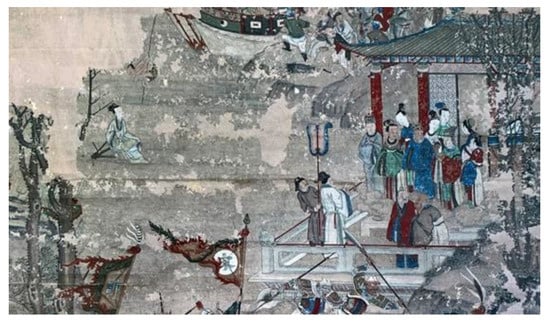
Figure 6.
The image of Mazu in the “One Family Honors”, one of the stories in the third picture of “Queen of Heaven Glorious Deeds Scroll”. Source: author’s photograph.
In the statues and images, the headwear, which shows the identity of Mazu’s heavenly concubine and queen of heaven, also comes in the form of a crown without tassels. Following the Ming dynasty, foreign missionaries came to China one after another and wrote monographs on what they had seen and heard in China. The missionary Dubose, Hampden Coit (1845–1910) painted the image of Mazu as he saw it in China in his book The Dragon, Image, and Demon, published in London, England, in 1886 (DuBose 1887) (as shown in Figure 7). That is to say, in the middle of the clairvoyant eye (Qianliyan 千里眼) and the downwind ear (Shufenger 順風耳), sat a Mazu wearing a crown without tassels and holding a Gui in her hand. A wooden statue of Mazu is worshipped at Lingci Temple 靈慈廟 in Nanji 南箕, a suburb of Putian City. The crown worn on the head is somewhat similar to that shown in printmaking. It is also a crown without tassels. The face looks thin and delicate. The chin is slightly pointed, without a double chin. The earlobes are large. The Gui is held on the chest and in front of the neck. The decoration and lacquer are mottled by age. The seat behind the god is a square stool (wudeng 杌凳). The crowns worn on the head are like the sky-reaching crown (tongtian guan 通天冠) and the travel crown (yuanyou guan 遠遊冠), but the number of beams (liang 梁) on the crowns is under twenty-four for the emperor and under eighteen for the crown prince, who has only nine. However, from the side view of this Mazu statue in Lingci Temple, the beam on the top of the crown is slightly wider than the former, and the part extending from the side of the crown behind the ear appears as sideburns. According to the Collection of Rituals of Great Jin Dynasty (Dajin jili 大金集禮), there are two sideburns in the crown of the empress of the Song dynasty (Zhang 1985). The dress crown of the empresses in the Ming dynasty inherited these sideburns in the Song dynasty (Zhang 2013). This kind of crown style, with beams and sideburns, also appeared in some flat Mazu images, such as the water and land painting of the Virgin Mary in Xilai Temple 西來寺 in the Ming dynasty (as shown in Figure 8). The Mazu statue on display at the Overseas Transportation History Museum in Quanzhou 泉州海外交通史博物館, Fujian Province, is very similar to a Qing dynasty wooden statue of Mazu in the collection of the Taiwan Museum of History 臺灣歷史博物館. The crown is very similar. Mazu wears a crown on her head, followed by broad sideburns. Her solemn and kind face has a kind smile, sitting on an armchair. This kind of combination of the crown and sideburns is similar to the combination of the crown of the emperor (without a beam crown) and the queen (with the sideburns after the phoenix crown), to reflect the nature of Mazu as a god like an emperor and a concubine.
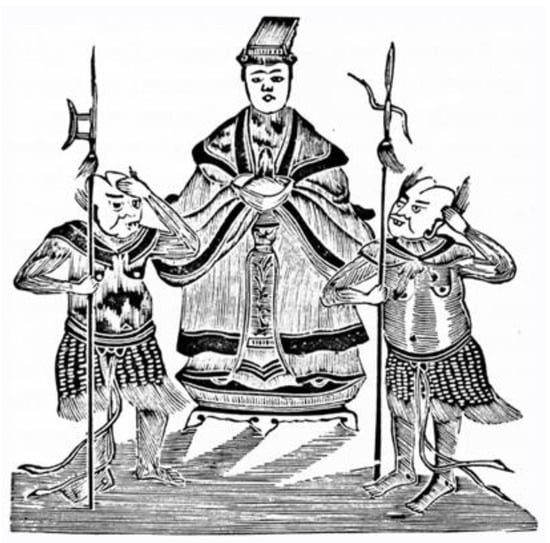
Figure 7.
Printmaking Mazu. Source: The Dragon, Image, and Demon, 1886, p. 388.
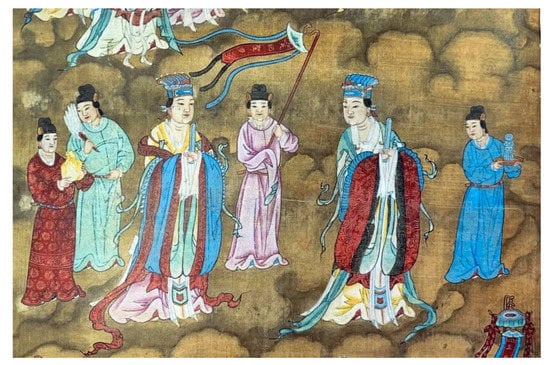
Figure 8.
The water and land painting of the Virgin Mary in Xilai Temple in the Ming dynasty. Source: author’s photograph.
If the crown is a conventional crown symbol that is more in line with Mazu’s status as the queen of heaven, then, from 11 May 2011 to 13 November 2011, in the first special exhibition room of the Taiwan Museum of Natural Science 臺灣自然科學博物館, the “Culture Exhibition of Flowing Goddess Taiwan Mazu and Offering Incense to Mazu” was exhibited. Among the Mazu statues provided by Zhenlan Palace 鎮瀾宮 in Dajia 大甲, Taiwan, there is a wood-carved and painted Mazu statue (as shown in Figure 9 left), which is more similar to the identity of Mazu as a concubine. Mazu’s head is tied in a high bun on the top, and the front of the high bun is decorated with a phoenix crown decorated with a phoenix spreading its wings, which vividly shows the true beauty of the imperial concubine. In January 2014, when the author made a special trip to Yuanchanghang 元昌行, a century-old house in Lukang, Taiwan, to visit Mr. Li Yixing 李奕興, the text writer who participated in the exhibition, he explained the specific situation of the exhibition at that time, as well as all the artworks he hand-painted for the Mazu statue that was exhibited at that time. Another bronze Mazu statue in the Ming dynasty (Figure 9 right), also provided by Zhenlan Palace in Dajia Town, has a very round and full face, and the head is also tied in a high bun, but the phoenix head is decorated in front of the high bun. Extending all the way to the forehead, the crown also stretches to the ears on both sides, vividly conveying the agility of a phoenix that is about to spread its wings.
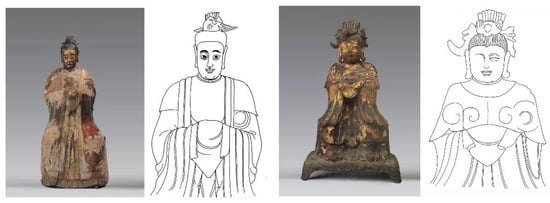
Figure 9.
Mazu statue in Zhenlan Palace, Dajia, Taiwan. Source: Photographed and drawn by the author.
Secondly, in addition to the variety of Mazu’s crowns, Mazu’s appearance is also very changeable, and can be described as indefinite. Mazu’s chairs range from simple stools in the Southern Song dynasty to large-scale and heavy chairs in the Yuan, Ming and Qing dynasties, with various types of Taishi’s circle chairs (taishi quanyi 太師圈椅) (Figure 10D), dragon head chairs (longtou yi 龍頭椅), and stepping chairs (tajizuo 踏幾座) (Figure 10B,F), which are full, curved and richly carved. Although Mazu’s posture is mainly upright, due to the changes in the shape of the seat, Mazu’s gestures include holding her hands in front of her chest and placing her hands on the handle of the armchair (Figure 10B,G). Sometimes hand or both hands hold Gui (Figure 10A), Ruyi 如意 (an S-shaped ornamental object, usually, made of jade, formerly a symbol of good luck) (Figure 10B,G), Hu 笏 (a tablet held before the breast by officials when received in audience by the emperor) (Figure 10D,F), fan, handkerchief, etc. There are different forms, such as a hidden hand style (Figure 10E), hanging hand style, and facing-the-sky style (Figure 10C). Thirdly, Mazu’s body dress is also simple and complex; there are differences between the double-breasted style (Figure 10E) and the round-collared style; there are cloud shoulders hanging on the shoulders (Figure 10F), and there are no cloud shoulders (Figure 10B,C,G); there are no decorative patterns on the body dress, and there are complex decorative patterns; there is a young woman with a delicate face and a slender body (Figure 10C), and a mother with a plump body and face (Figure 10F). There are three types of facial colors: gold (Figure 10A), pink (Figure 10F), and black. The hundred variations of Mazu statues that emerged during the Yuan, Ming and Qing dynasties were influenced not only by factors such as places of worship, groups of worshippers, and regions in belief, but also by the techniques and aesthetic concepts of the mainstream idols of different historical periods, which also constituted major influencing factors.
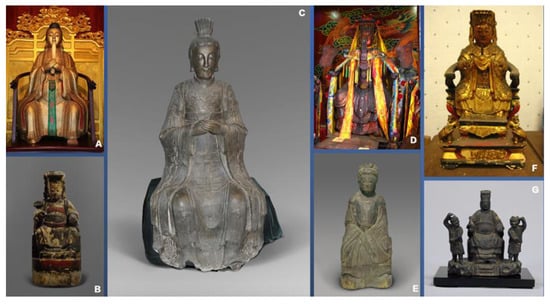
Figure 10.
The image of Mazu in three-dimensional statues since the Ming and Qing dynasties ((A) Bronze Statue of Mazu in Xianying Palace, Temple Island 廟島; (B) The painted wooden statue of Mazu in the early Qing dynasty in the Tianhou Palace, Lukang, Taiwan; (C) The bronze statue of Mazu in the Ming Dynasty collected by Nantong 南通 Museum; (D) Hard-bodied Mazu statue at Kaiji 開基 Tianhou Temple, Tainan City, Taiwan; (E) Carved wooden statue of Mazu in Zhenlan Temple, Dajia, Taiwan; (F) Statue of Mazu from Laoshen Tang 老神堂, Tainan City, Taiwan; (G) Statue of Mazu in Qing dynasty in Japanese Museum). Source: Photographed by the author.
4. Figure of “Maritime God” and the Typical Mazu Image
4.1. “Maritime God”: Mazu Image in “the Image of God and Things (shenwu xiangtong 神物象通)”
Due to the respect from the imperial court at the national level, the Mazu image as the “maritime god” has spread all over the country, and many Mazu official temples have appeared in various places, which were established by the state or worshipped by the imperial court to serve the state. However, the belief in Mazu has been rooted, extended and even flourished among people everywhere, without promotion at the official level. Fujian maritime merchants constitute an important path and carrier for the spread of Mazu beliefs. Especially since the Qing dynasty, all parts of China’s coastal areas have been incorporated into a closely linked maritime trade network. The promotion and development of coastal trade have made the Mazu image with the nature of a “maritime god” suddenly become a cultural identification method that can be accepted by maritime merchants all over China’s coastal areas. As a result, Mazu has gradually evolved from the “Fujian maritime god” to the “national maritime god”.
The “maritime god” has become a common identification method in Mazu beliefs across the country. However, this does not mean that the Mazu image is merely extended from “maritime god in Fujian” to “maritime god in China”. In fact, the Mazu image is changeable. With the rise and spread of maritime trade, Mazu has gradually become a national deity, believed by both the government and the people since the Yuan, Ming and Qing dynasties. As Mazu can constantly change its image with changes in time, place, conditions and other environments to meet the different spiritual needs of different groups of people, Mazu has a changeable deity image. That is to say, since the first appearance of the Mazu image, it has underwent constant new changes and, in the process of this dynamic change, the various images of the Mazu image often coexist in many places and at the same time. For example, the women, children, young and old in the Fujian region devoutly worship the Mazuwho is like a mother as the “homeland god”, the Mazu who is solemnly enshrined in the imperial court with the image of the “navy god”, and the merchants who are engaged in maritime trade with different origins in various coastal areas, and Mazu, the revered messenger-like “navigation god” (hanghai zhi shen 航海之神). These all appeared in the Fujian region and in various provinces along the navigation line within the same historical period, coexisting in official and civil society.
Objects and images connect the spirit, and Fujian merchants who are immersed in the local culture will definitely take the Mazu belief with them when they go to other places. The custom of Fujian merchant ships worshipping the Mazu statue has a long history. Among the materials deposited in the Japan Metropolitan City Historical Archives 日本都城歷史資料館 is a Mazu statue, the company (peisi 陪祀) and its shrine on the boat in the Tang dynasty (boat in Ming dynasty), handed down from the ancient city of Tangshen 唐神 Town in the Edo period. From 6 October to 2 December 2018, the Mazu statue, the company, and its shrine participated in the international exchange exhibition “Japanese and Korean Sacrificial Relics in God House and Sea Mountain” of the Western Metropolitan Archaeological Museum 西都原考古博物館. The Kobe Municipal Museum in Japan 日本神戶市立博物館 has a collection of woodcut prints from the Edo period, all of which depict that, after the Tang ship (tangchuan 唐船) reached the shore, the Tang people (tangren 唐人) invited the queen of heaven to disembark, who was escorted by the merchant ship, with sound gongs and dance sticks along the way, clearing the way to enter the temple (Figure 11). This can be seen from the distances of Fuzhou 福州, Nanjing, Shandong, Beijing, Guangdong and Yunnan to Nagasaki 長崎, Japan, which are engraved in the The Picture of Tang Ship (tangren chuan zhitu 唐人船之圖) collected by the museum. Since the Qing dynasty, it has become more and more common for merchants outside Fujian to believe in Mazu. Mazu shrines set up on merchant ships have become the common custom of merchant ships all over the country, and Mazu belief has become the belief of the whole people. Mazu temples, as places for Mazu worship, gradually broke away from the nature of guild halls (huiguan 會館) and official color, and gradually penetrated the folk of various places (Schottenhammer 2010). The worship of Mazu became an integral part of local folk customs and folk culture. The folk image of Mazu is different from that of Fujian, and it is also quite different from the Mazu image worshipped by maritime merchants. However, the “maritime god” image is still the most prominent, typical and tenacious among the many images of Mazu. Fujian maritime merchants have played a vital role in the spread of Mazu belief and the expansion of its image. However, Mazu can break through regional limitations, extend over a wider range and become a universal belief. Its ability to overcome the gods in different regions has led it to becoming the gods that maritime merchants worldwide are willing to believe in together. This community beliefcan establish a common, long-cherished wish and identity of the image of the “maritime god” to meet the spiritual needs of the national belief community.
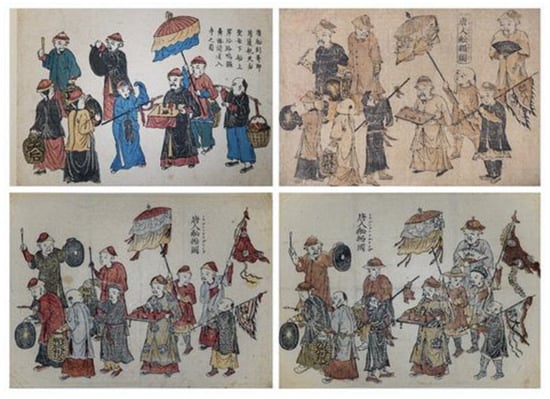
Figure 11.
The painting of a Chinese Boat in the collection of the Kobe Municipal Museum, Japan. Source: The Kobe Municipal Museum, Japan.
4.2. The Typical Mazu Image: The Golden Body Is Like One (jinshen ru yi 金身如一)
Originating from the Greek word “tupos”, type is an aesthetic term in ancient Greece and a means of expression in the literature; that is, an artistic image created by writers and artists by means of typification, which not only has a vivid personality, but also contains the universal content of society and life. The typical image of art is a universal essence and law that not only has vivid and distinct personality characteristics but can also be highly summarized and embodied. The image of Mazu’s “maritime god” mentioned above is a typical example of Mazu’s ever-changing image, whose emergence and development are restricted by specific historical conditions, cultural background and the realistic environment of navigation trade. It is an artistic form in which ship merchants place their universal demands on an image. It takes the Mazu temple, sacrifice, legend and myth, culture and art as the main carrier of concretization.
There is a difference between the typical image in the perspective of art and the typical image at the aesthetic level. The latter includes not only perceptual impressions and intuitive representation, but also the result of thinking in images, which could also be said to be concrete ideas. The former emphasizes that the artistic image forms a materialized carrier through the artistic expression method at the concrete level. Although the theory or concept of “type” has not been put forward in the development of Chinese art history, the concept of “unity of form and spirit” (xingshen jianbei 形神兼備) has been put forward, such as Xun Kuang’s 荀況 (About BC 313–238) Xunzi 荀子, which mentions that “born first is the physical body, from which spiritual functions are derived” (xingju er shensheng 形具而神生) (Yang 2014), Gu Kaizhi 顧愷之 (348–409), in the Eastern Jin dynasty 東晉 (317–420), put forward the idea of “depicting the spirit through form and learning from nature itself” 以形寫神、師法造化, Xie He 謝赫 (date unknown) in the Southern Qi dynasty 南齊 (479–502) put forward “The depiction being similar to the reflected object” (yingwu xiangxing 應物象形) and “go beyond the external form of the object to find its spiritual depths” (qu zhi xiang wai 取之象外) (Xie and Yao 1959), etc. Whether painting or the creation of gods, it pays attention to “unity of form and spirit”, which is the origin of tracing the typical theory at the level of art. Folk Mazu statue art belongs to the history of ancient Chinese art, and its typical form is one of the ideal forms of Mazu statue, which mainly refers to a kind of folk religious image that can highlight Mazu’s charming personality characteristics in the process of shaping the Mazu image. It can be said that the typical Mazu image not only has the individuality of folk idol art but also has the universality of folk idol art.
First, the typical Mazu image is related to the representative goddess image in folk idol art. The typical Mazu image has the common characteristics of female deities such as Avalokitesvara, Lady Linshui, Lady of Blue Clouds (Bixia yuanjun 碧霞元君) and Golden Mother of Yaochi (Yaochi jinmu 瑤池金母), which have significant influence among the people. There is a folk proverb in China that “North Yuanjun, South Mazu” 北元君、南媽祖. In the original folk belief, Bixia Yuanjun, located on Mount Tai 泰山, was in charge of human fertility, blessing the health and safety of women and children; Mazu, located in Fujian, sheltered the well-being of sea travelers. At the same time, the two goddesses performed their duties, which were quite different. Nonetheless, after the late Ming dynasty, the two goddesses of the North and South gradually merged in terms of the Godhead. Bixia Yuanjun received prayers to protect water transport, and Mazu accordingly became a multi-functional deity to fight epidemics and protect pregnancy and childbirth. In addition, the spread of Mazu’s beliefs to the north after the Yuan dynasty led to its further integration with Bixia Yuanjun. The similarity between these two goddesses’ images can be seen in the flat images of Ming and Qing dynasties. For example, on the left and right sides of the west wall of the main hall of Princess Temple 公主寺 in Fanshi 繁峙, Shanxi 山西 Province, the Holy Mother of Houtu (Houtu shengmu 後土聖母) and the Holy Mother of Heavenly Concubine are depicted, respectively (Jin 2011). Suppose we do not look at the words “Mother of Heavenly Concubine” and “Mother of Houtu” beside the two goddesses. In that case, it is not easy to identify and distinguish the identities of the two goddesses from only their plump and clean appearance, elegant phoenix crown robes, smooth lines, delicate and agile descriptive techniques, and the attendants (peishi 配侍) behind them. Another example is the two goddesses in the front row (as shown in Figure 12) in the painting of the Empress Dowager Cisheng 慈聖 in the portrait of the Mother of Heavenly Concubine and Bixiayuanjun (Tianfei shengmu bixia yuanjun xiang 天妃聖母碧霞元君像), all wearing beam-style sideburns and a rosy robe with big sleeves, holding Gui in both hands, and having the same facial shape and body characteristics, if not carefully identified and distinguished by the number of beams, cuffs, skirts and the color of the head light. It is challenging to identify which goddess is Mazu and which is Bixia Yuanjun.
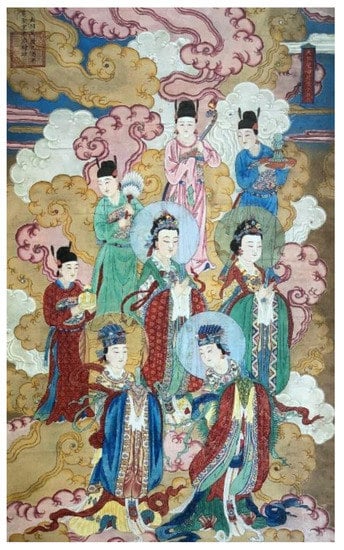
Figure 12.
The portrait of the Mother of Heavenly Concubine and Bixiayuanjun. Source: author’s photograph.
A water and land painting in the Ming dynasty on the silk scroll Pictures of Holy Mother and Heavenly Concubine (Tianfei shengmu zhongtu 天妃聖母眾圖) in Miaoyuan Temple 妙源寺, Gosaki 剛崎 City, Japan, is very similar to the water and land painting style of Baoning Temple 寶寧寺. The four figures in the painting wear phoenix crowns. Except for the color of the headlight and the pattern of the cuffs, the goddess is almost the same in terms of clothing and gestures, and it is difficult to identify which is the goddess and which is the concubine. As the goddess’s divine power has a certain commonality, the goddess image in statues and images is presented in a comprehensive materialized form through the subjective ideas of craftsmen and the psychological images, inner images, generalized images, conceptual images and aesthetic images of the people. As a result, folk goddesses have a typical image: they all wear wide-mouthed robes with oversized sleeves, cloud shoulders, and pointed shoes, and their appearance, body shape, and posture are all similar to middle-aged and older women. Many people will, therefore, be misidentified or even misrepresented. Of course, Mazu also has a uniqueness and personality among the many goddesses. Due to the high godhood of Mazu, images and statues are often highlighted by the crown of the head, hand-held instruments and other unique shapes, but this is not enough to reflect the personality of Mazu statues. The most significant difference from other goddesses is reflected by two points: one is Mazu’s hair bun under the crown and on the back of her head. Mazu’s hair bun retains the sail-shaped bun (chuanfan ji 船帆髻), which was often combed by women along the coast of Putian, Fujian Province, in early years; that is, the hair on both sides of the back of the head is gathered in the middle, and then gathered into a flaky bun resembling a sail. This kind of bun style and custom is still popular among folk women’s hairstyles in the coastal areas of Fujian. The second is that the clairvoyant eye and the downwind ear represented unique matching gods (peishen 配神) behind the Mazu, different from other goddesses. Although there are several legends about the origin of the clairvoyant eye and the downwind ear, both of them say that clairvoyance and the downwind ear are the protectors (hujiang 護將) of Mazu and, together with Mazu, they relieve the ordinary people, which constitutes an indispensable part of Mazu culture and the combination of gods.
Secondly, the typical Mazu image is related to the numerous Mazu images in the art of images and statues. Since the Song dynasty, various Mazu images have existed over different historical periods. Based on the textual research of the Mazu statues and images in different periods, we can find the rules of their modeling, that is, the typical images in different historical periods. Mazu in the Song dynasty was a homeland god, so its typical image was based on the feudal ethical hierarchy and aesthetic habits of the Song people, taking the image of folk women as the prototype. Their hair bun, clothes style and whole appearance were mainly plain and simple, highlighting the secularity and ideality of the Mazu image. Compared with the imperial court of the Song dynasty, the Yuan dynasty paid more attention to Mazu, and the status of Mazu’s godhood was promoted to a higher level, because the Mazu image changed from the simple style of the Song dynasty to the rich and gorgeous style reflected by the patterns in the clothes and Mazu’s sitting in a specific, heavy shape, along with the full and colorful decoration. Mazu’s dress in the Ming dynasty incorporates the appearance of the imperial concubines, highlighting the nature of the imperial concubines. At the same time, the appearance has the common characteristics of the Avalokitesvara statue, and the body is tall and slender. During the late Ming and early Qing dynasties, Mazu’s clothing had a round neck style, the shape of the arms on both sides of the armchair began to appear, and the posture began to tend toward sitting in a large armchair. In the middle of the Qing dynasty, Mazu’s body tended to be plump, with a round belly and an official appearance, and the seat was a Taishi-style round chair with several feet. After the end of the Qing dynasty, Mazu’s appearance became more and more complex and diverse. Thus, it can be seen that the typical Mazu image in different historical periods is influenced by the title of Mazu’s priesthood on the one hand, and is the product of the integration of secular clothing, myths and legends, and cultural characteristics. On the other hand, the Mazu image was influenced by other arts and crafts in the same period, showing the popularity of the folk Mazu composition materials and the broad mobility of the market.
5. Conclusions
The initial image of Mazu was a woman from a folk family in rural Fujian in Song dynasty. Owing to her divine power to predict misfortune and good fortune, she appeared in the public eye as a witch of compassion and good deeds. Afterwards, she was officially ordained, and her godhood was constantly upgraded. Different from other goddesses, Mazu has also experienced the absorption and deification of its image by Confucianism (Rujia 儒家), Buddhism (Fojiao 佛教) and Daoism (Daojiao 道教). Mazu is not only regarded by Confucianism as a Buddhist Bodhisattva, a loyal and filial goddess to protect the country and defend the countryt, but also a Taoist immortal. For example, in the legend of Celestial Consort Mother (Tianfei niangma zhuan 天妃娘媽傳), Mazu is listed as a Taoist immortal system, who is the daughter of Beitian Miaoji Xingjun 北天妙極星君. It is also recorded in Scripture of Lord Lao, the Most High, Speaking on the Numinous Efficacy of the Celestial Consort in Relieving Distress (TaiShang laojun shuo tianfei jiuku lingyan jing 太上老君說天妃救苦靈驗經) that Mazu was a fairy (xianü 仙女) who was reborn on earth at the behest of TaiShang LaoJun to save human suffering. Mazu was gradually incorporated into the complicated and multifaceted Taoist deity system, and then worshiped in Taoist temples. Therefore, the image of Mazu has become a traditional cultural image of the Chinese nation, which integrates Confucianism, Buddhism and Daoism.
The Mazu statues and images are a true record and artistic practice of Mazu belief and custom, integrated into the visual impression of folk life; they are a kind of traditional concept and recognized behavior of Mazu belief and custom established by the folk for a long time; they are a form of artistic presentation to specifically embody and creatively express Mazu, the core figure of Mazu belief and custom; they are a uniquely tangible and silent carrier of Mazu’s sacrificial rites stories, legends and folk customs. The initial, transformed and typical images of Mazu in the images and statues are a mapping and portrayal of the culture of Mazu in different historical periods, and are objects of worship that the faithful can perceive as symbols and incarnations of the gods, a way of presenting the material carrier of the divine personality and spirituality in real life. First of all, the initial Mazu image is presented in the belief circles of Fujian, Guangzhou, Chaoshan and Taiwan, which have similar cultural traditions to Fujian. Since ancient times, the worship of goddesses in Fujian and Guangdong has been more popular, and the status of goddesses is higher than that of male gods. From Tailao 太姥 in ancient times, who was regarded as the first grandmother by the Fujian people, to Ma Xian 馬仙, Chen Jinggu, Shen Qiniang 莘七娘, etc. in Tang and Song dynasties, they gradually became the dominant gods, which had an important impact on Fujian cultural circle and belief circles. Therefore, to a certain extent, the initial Mazu image was inevitably influenced by images of other goddesses of the previous generation or the same period. Secondly, the transformation of the Mazu image is accompanied by the constant interaction and cooperation between the people and the government, thus creating its diversity and variability. Due to the spread of Mazu beliefs and the expansion of the priesthood, Mazu beliefs and customs have been implemented and localized in different regions, and different Mazu images have emerged. Finally, the typical Mazu image is the condensed and improved image of Mazu’s transformation. Influenced by factors such as belief circle and production techniques, there is a representative image that has become a model (dianfan 典範) through screening and summarizing the typical Mazu images in different historical periods, looking at the many images of Mazu’s transformation.
The religious overtones of folk beliefs give Mazu its unique image and human connotations. As a medium of communication between humans and gods, the Mazu statue is not only an artificially constructed social cultural symbol, but also a folk-art symbol that combines religion and folklore, secularity and emotion at the visual level. Although the deity Mazu and her life story are so familiar that they have been worshipped by people from all walks of life, believers’ perception of her image is only at the imaginary level. Thus, when people distinguish Mazu from other deities, they mostly base their judgment on the sacrifices and riding animals associated with Mazu, rather than Mazu’s physical features. The ambiguity of Mazu’s specific image has led to general confusion in the impressions and perceptions of the believers. The Mazu shape is the sacrifice object that believers perceive as the symbol and incarnation of gods. It is a way of presenting the material carrier of god and spirituality in real life and it is the visual form of Mazu’s intuitive representation and materialization. As a medium of communication between human beings and gods, the Mazu image is not only a social cultural symbol constructed by human beings, but also a folk art symbol with features of religion and folklore, as well as secularity and emotion, at the visual level. It carries a certain representative thought and concept, meaning and spirit, and the various pieces of information it contains are more intuitive than words, providing the incomparable dissemination power of knowledge and information of the classics. Moreover, it can transcend language barriers and regional boundaries, stimulate personal inner original feelings, interact with Mazu’s beliefs and customs, and serve as an important medium for spreading Mazu’s beliefs and customs.
Author Contributions
Conceptualization, B.Z.; funding acquisition, B.Z. and X.S.; project administration, B.Z.; resources, B.Z.; supervision, X.S.; writing—original draft, B.Z.; writing—review & editing, B.Z. and X.S. All authors have read and agreed to the published version of the manuscript.
Funding
This research was funded by National Social Science Fund of China, grant number 14CG131; 20BG119; 21BG106.
Conflicts of Interest
The authors declare no conflict of interest.
References
- Boltz, Judith Magee. 1986. In Homage to T’ien-fei. Journal of the American Oriental Society 106: 211–32. [Google Scholar] [CrossRef]
- Chen, Rongming 陳容明. 2006. Mazu de chusheng he chushen 媽祖的出生和出身 (The Birth and Origin of Mazu). Paper presented at the 2006 Nian Zhonghua Mazu Wenhua Xueshu Luntan Huiyi Lunwen 2006年中華媽祖文化學術論壇會議論文, Tianjin, China, September 1. [Google Scholar]
- Chen, Wangdao 陳望道. 2007. Mazu Xinyang Shi Yanjiu 媽祖信仰史研究 (A Study of the History of Mazu’s Faith). Fuzhou: Haifeng Chubanshe 海風出版社, p. 265. [Google Scholar]
- Dubose, Hampden Coit. 1887. The Dragon, Image, and Demon: Or, The Three Religions of China; Confucianism, Buddhism and Taoism, Giving an Account of the Mythology, Idolatry, and Demonolatry of the Chinese. London: Samuel William Partridge and Company Publishing. [Google Scholar]
- Huang, Yansun 黃岩孫. 1989. Xianxi Zhi (Juan San) 仙溪志(卷三) (Gazetteer of Xianxi, Volume 3). Xianyou Xian Wenshi Xuehui Dianxiao 仙游縣文史學會點校. Fujian: Fujian Renmin Chubanshe 福建人民出版社, p. 62. [Google Scholar]
- Jin, Weinuo 金維諾. 2011. Zhongguo Siguan Bihua Quanji (Juan San): Mingqing Siguan Shuilu Fahui Tu 中國寺觀壁畫全集(卷3): 明清寺觀水陸法會圖 (The Complete Collection of Chinese Temple Murals (Volume 3): Paintings for Religion Rituals at Ming and Qing dynasty temples land puja). Guangzhou: Guangdong Jiaoyu Chubanshe 廣東教育出版社, pp. 69, 74. [Google Scholar]
- Ke, Guosen 柯國森. 1991. Putian Xian Zongjiao Zhi 莆田縣宗教志 (Religious Records of Putian County). Putian: Putian Xian Shiwu Zongjiao Ju 莆田縣事務宗教局, p. 350. [Google Scholar]
- Li, Xianzhang 李獻璋. 1995. Mazu Xinyang Yanjiu 媽祖信仰研究 (Research on the Cult of Mazu). Macau: Macau Haishi Bowu Guan Chubian 澳門海事博物館出版. [Google Scholar]
- Li, Bozhong 李伯重. 1997. “Xiangtu Zhi Shen”, “Gongwu Zhi Shen” yu “Haishang Zhi Shen”: Mazu Xingxiang de Yanbian “鄉土之神”、“公務之神”與“海商之神”: 媽祖形象的演變 (“Homeland God”, “Official God”, and “Maritime God”: The Evolution of Mazu Image). Zhongguo Shehui Jingji Shi Yanjiu 中國社會經濟史研究 2: 47–58. [Google Scholar]
- Li, Bozhong 李伯重. 2004. Qianli Shixue Wencun 千里史學文存 (A Thousand Miles of History and Literature). Hangzhou: Hangzhou Chubanshe 杭州出版社. [Google Scholar]
- Lian, Zhenbiao 連鎮標. 2005. Duoyuan Fuhe de Zongjiao Wenhua Yixiang——Linshui Furen Xingxiang Tankao 多元複合的宗教文化意象——臨水夫人形象探考 (A Multifaceted Religious Cultural Imagery—An Exploration of the Image of Lady Lin Shui). Shijie Zongjiao Yanjiu 世界宗教研究 1: 132. [Google Scholar]
- Liang, Kejia 梁克家. 2000. Sanshanzhi (Juan Jiu) 三山志 (卷九) (Gazetteer of Three Mountains, Volume 9). Fuzhou: Haifeng Chubanshe 海風出版社, p. 119. [Google Scholar]
- Lin, Meirong 林美容. 2003. Taiwan Mazu Xingxiang De Xian Yu Yin 臺灣媽祖形像的顯與隱 (The Explicit and Concealed Image of Mazu in Taiwan). Wenhua Zazhi 文化雜誌 48: 131–36. [Google Scholar]
- Lin, Ruikai 林瑞愷. 2020. Dangdai Taihai Guanxi Xia De Mazu Xingxiang Jiangou: Yichang Jieyan Housu Ao Yumin De Jiti Chaosheng Xingdong 當代台海關係下的媽祖形象建構: 一場解嚴後蘇澳漁民的集體朝聖行動 (The Image-Building of Matsu in the Morden Cross-Strait Relationship: A Study of the Su’ao Fishers’ Pilgrimage after the Lifting of Martial Law in Taiwan). Si Yu Yan: Renwen Yu Shehui Kexue Qikan 思與言: 人文與社會科學期刊 2: 53–103. [Google Scholar]
- Liu, Ji 劉基. 1999. Liuji Ji (Juan Shier) 劉基集 (卷十二) (Liu Ji Collection, Volume 12). Lin jiali Dianjiao 林家驪點校. Hangzhou: Zhejiang Guji Chubanshe 浙江古籍出版社, p. 175. [Google Scholar]
- Liu, Kezhuang 劉克莊. 2011. Liu Kezhuang ji jianjiao (Juan Sishiba) 劉克莊集箋校(卷四十八) (The Collation and Comment of Liu Kezhuang’s Anthology, Volume 48). Xin Gengru Jianjiao 辛更儒箋校. Beijing: Zhonghua Shuju 中華書局, p. 2467. [Google Scholar]
- Lo, Vivienne. 1993. The Legend of the Lady of Linshui. Journal of Chinese Religions 21: 69–96. [Google Scholar] [CrossRef]
- Ptak, Roderich, and Jiehua Cai. 2017. The Mazu inscription of Chiwan (1464) and the early Ming voyages. Zeitschrift der Deutschen Morgenländischen Gesellschaft 167: 191–214. [Google Scholar] [CrossRef]
- Ruitenbeek, Klaas. 1998. Mazu, the God of Sea Protection in Paintings and Woodcuts, Proceedings of the 1995 Macao Seminar on the History and Culture of Mazu Faith. Macao: Museu Marítimo and Macao Cultural Studies Association, p. 232. [Google Scholar]
- Sangren, P. Steven. 1983. Female Gender in Chinese Religious Symbols: Kuan Yin, Ma Tsu, and the” Eternal Mother”. Signs: Journal of Women in Culture and Society 9: 4–25. [Google Scholar] [CrossRef]
- Schottenhammer, Angela. 2010. Brokers and “Guild” (huiguan 會館) Organizations in China’s Maritime Trade with her Eastern Neighbours during the Ming and Qing Dynasties. Crossroads 1: 99–150. [Google Scholar]
- Song, Lian 宋濂. 1976. Yuanshi (Juan Shi) 元史 (卷十) (History of the Yuan Dynasty, Volume 10). Beijing: Zhonghua Shuju 中華書局, p. 204. [Google Scholar]
- Tuojin 托津. 1991. Qinding daqing huidian shili (Jiaqing Chao) (Juan Sanbai Liushier) 欽定大清會典事例(嘉慶朝)(卷三百六十二) (Collected Statutes of the Qing during the Reign of Jiaqing, Volume 362). Taipei: Wenhai Chubanshe 文海出版社, p. 6076. [Google Scholar]
- Wang, Yingying 王英暎. 2014. Fujian Minjian Shengji Tu Zhong Mazu Xingxiang De Duochong Juese 福建民間聖跡圖中媽祖形象的多重角色 (The Multiple Roles of Mazu Images in Fujian Folk Sagely manifestation Pictures). Meishu Guancha 美術觀察 8: 114–17. [Google Scholar]
- Xie, Zhaojiu 謝肇淛. 1935. Wuzazu (Juan Shiwu) 五雜俎(卷十五) (Five Assorted Offerings, Volume 15). Shanghai: Zhongyang Shudian 中央書店, pp. 289–90. [Google Scholar]
- Xie, He 謝赫, and Zui Yao 姚最. 1959. Guhua Pinlu 古畫品錄 (Record of Classification of Ancient Paintings). Wang Bomin Biaodian Zhuyi 王伯敏標點注譯. Beijing: Renmin Meishu Chubanshe 人民美術出版社, pp. 1, 8. [Google Scholar]
- Yang, Liang 楊倞. 2014. Xun Zi (Juan Shiyi) 荀子(卷十一). Geng Yun Biaojiao 耿芸標校. Shanghai: Shanghai Guji Chubanshe 上海古籍出版社, p. 199. [Google Scholar]
- Ye, Mingsheng 葉明生. 2010. Linshui Furen yu Mazu Xinyang Guanxi Xintan 臨水夫人與媽祖信仰關係新探 (A New Study on the Relationship between Lady Linshui and Mazu’s Beliefs). Shijie Zongjiao Yanjiu 世界宗教研究 5: 70–80. [Google Scholar]
- Ye, Xingguo 葉興國, and Guoyu Zhang 張國玉. 1997. Ninghua Xian Chengqu Tianhou Gong de Chuantong Miaohui甯化縣城區天后宮的傳統廟會 (Traditional Temple Festivals at Tin Hau Temple in the urban area of Ninghua County), Ninghua Wenshi Ziliao (Di Shibaji) 甯化文史資料 (第十八輯) (Ninghua Cultural and Historical Materials (18th Series)). Fujian: Ninghua Yizhong Yinshuachang Yin 甯化一中印刷廠印, p. 7. [Google Scholar]
- Yu, Rongmin 余榮敏. 2007. Nüquan Shijiao xia de Mazu Xingxiang Jiedu 女權視角下的媽祖形象解讀 (Interpretation of Mazu’s Image from the Perspective of Feminism). Fujian Sheng Shehui Zhuyi Xueyuan Xuebao 福建省社會主義學院學報 4: 34–37. [Google Scholar]
- Zhang, Wei 張瑋. 1985. Dajin Liji (Juan Ershijiu) 大金集禮(卷二十九) (Collection of Rituals of Great Jin Dynasty, Volume 29). Beijing: Zhonghua Shuju 中華書局, p. 251. [Google Scholar]
- Zhang, Tingyu 張廷玉. 2013. Mingshi (Juan Liushiliu) 明史(卷六十六) (History of the Ming Dynasty, Volume 66). Beijing: Zhonghua Shuju 中華書局, pp. 1621–22. [Google Scholar]
- Zhang, Yanchao. 2019. The State Canonization of Mazu: Bringing the Notion of Imperial Metaphor into Conversation with the Personal Model. Religions 10: 151. [Google Scholar] [CrossRef]
- Zheng, Zhiren 鄭智仁. 2013. Aomen Xiandai Shige Zhong De Mazu Yixiang Tanjiu 澳門現代詩歌中的媽祖意象探究 (A Study on Mazu Imagery of Modern poetry in Macao). Zhongguo Xiandai Wenxue 中國現代文學 24: 147–66. [Google Scholar]
Publisher’s Note: MDPI stays neutral with regard to jurisdictional claims in published maps and institutional affiliations. |
© 2022 by the authors. Licensee MDPI, Basel, Switzerland. This article is an open access article distributed under the terms and conditions of the Creative Commons Attribution (CC BY) license (https://creativecommons.org/licenses/by/4.0/).